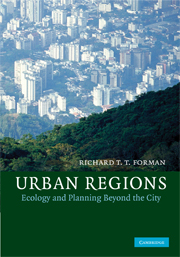Book contents
- Frontmatter
- Contents
- Foreword
- Foreword
- Preface
- Acknowledgments
- 1 Regions and land mosaics
- 2 Planning land
- 3 Economic dimensions and socio-cultural patterns
- 4 Natural systems and greenspaces
- 5 Thirty-eight urban regions
- 6 Nature, food, and water
- 7 Built systems, built areas, and whole regions
- 8 Urbanization models and the regions
- 9 Basic principles for molding land mosaics
- 10 The Barcelona Region's land mosaic
- 11 Gathering the pieces
- 12 Big pictures
- Appendices
- References
- Index
- Plate section
6 - Nature, food, and water
Published online by Cambridge University Press: 04 August 2010
- Frontmatter
- Contents
- Foreword
- Foreword
- Preface
- Acknowledgments
- 1 Regions and land mosaics
- 2 Planning land
- 3 Economic dimensions and socio-cultural patterns
- 4 Natural systems and greenspaces
- 5 Thirty-eight urban regions
- 6 Nature, food, and water
- 7 Built systems, built areas, and whole regions
- 8 Urbanization models and the regions
- 9 Basic principles for molding land mosaics
- 10 The Barcelona Region's land mosaic
- 11 Gathering the pieces
- 12 Big pictures
- Appendices
- References
- Index
- Plate section
Summary
The color maps of 38 urban regions represent a treasure chest for the curious. Opening this chest to discover intriguing and important patterns is the delight of this chapter and the next. Here we look rather directly for patterns in the areas of nature, food, and water. In chapter 5 we explore built systems, built areas, and whole regions to find significant natural systems and human use patterns.
Although nature, food and water are separated for sequential presentation purposes, clearly broad overlaps exist among the three categories. Nature often thrives both in food-producing areas and in water-bodies (Figure 6.1). Food products are harvested from both natural vegetation and aquatic ecosystems. And water is often abundant in both natural areas and farmland. Still, from a spatial planning perspective, providing for viable natural-vegetation areas, agricultural landscapes, and streams/rivers/lakes/aquifers/marine areas is fundamental.
With the treasure chest open before us, first we must consider how to find the nuggets. How do we sort through the mass of material and decipher key patterns. We are only looking for major patterns or results. Minor results, as well as major ones that we miss, will await discovery by others. So we start by briefly considering the important spatial-analysis process used to reveal the nuggets.
Spatial analysis for patterns
Intelligence agencies know that if you know what you are looking for, the chance of finding it increases enormously.
- Type
- Chapter
- Information
- Urban RegionsEcology and Planning Beyond the City, pp. 138 - 163Publisher: Cambridge University PressPrint publication year: 2008



